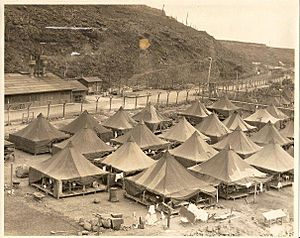Honouliuli National Historic Site facts for kids
Quick facts for kids Honouliuli National Historic Site |
|
|---|---|
| Lua error in Module:Location_map at line 420: attempt to index field 'wikibase' (a nil value). | |
| Area | 122.5 acres (49.6 ha) |
| Built | 1943 |
| Governing body | National Park Service |
| Website | Honouliuli National Historic Site |
| Official name: Honouliuli National Historical Site | |
| Designated | February 19, 2015 |
| Official name: Honouliuli Internment Camp | |
| Designated | February 21, 2012 |
| Reference no. | 09000855 |
The Honouliuli National Historic Site is located near Waipahu on the island of Oahu in Hawaii. This important place was once the Honouliuli Internment Camp. It was Hawaiʻi's biggest and longest-running camp where people were held during World War II. The camp opened in 1943 and closed in 1946.
On February 24, 2015, President Barack Obama named it a National Monument. Later, in 2019, it became the Honouliuli National Historic Site. The camp held 320 civilians and almost 4,000 prisoners of war. It was the only camp in Hawaiʻi built specifically for holding people for a long time during the war.
Building the Camp and How it Worked
The camp was built on 160 acres (0.65 km2) of land. It was near Ewa and Waipahu on Oahu. It was made to hold people who were moved from the Sand Island camp, which was closing. Honouliuli camp opened in March 1943.
The camp was surrounded by an 8-foot (2.4 m) tall double barbed-wire fence. Soldiers from the U.S. Army guarded the camp from eight watchtowers. Captain Siegfried Spillner was in charge. The camp was in a deep, isolated valley. Because of this, Japanese American people held there called it jigoku dani (地獄谷, "hell valley").
The camp was designed to hold 3,000 people. At one point, it held 320 American civilians. Barbed wire divided the camp into different sections. These sections were meant to separate people by their gender, nationality, and if they were military or civilian. By August 1943, there were 160 Japanese Americans and 69 Japanese people held there.
Over time, the camp held more than 4,000 people. These included Okinawans, Italians, German Americans, Koreans, and Taiwanese. Some of the first Korean prisoners arrived in late 1943 or early 1944. They were non-fighting workers captured during the Gilbert and Marshall Islands campaign. Three Korean soldiers, who were held in the camp, wrote a newsletter in Korean. It was called the Free Press for Liberated Korea.
Starting in 1943, Japanese American internees were either set free or moved to other camps. After November 1944, only 21 American civilians stayed at Honouliuli. The camp then mainly held prisoners of war. When the war ended, about 4,000 prisoners of war were at Honouliuli. They started being sent home in December 1945 and this continued into 1946.
Rediscovering and Protecting the Site
After the camp closed, the land was used for growing sugar cane. In 2007, the Monsanto Corporation bought the land.
For many years, people largely forgot that Honouliuli Gulch was once an internment camp. Fast-growing plants covered the area, and the old buildings fell apart. In 2002, Jane Kurahara, a volunteer from the Japanese Cultural Center of Hawai‘i, found the site. She used an old photo and traced an aqueduct in the background.
Learning more about the camp's history caught the attention of the National Park Service (NPS). An NPS study found that the camp was important enough to be listed on the National Register of Historic Places. The site was added to the register on February 21, 2012.
On February 24, 2015, President Barack Obama officially made it the Honouliuli National Monument. A special ceremony was held on March 31, 2015. Important people like the Secretary of the Interior and the Governor of Hawaiʻi attended. The John D. Dingell, Jr. Conservation, Management, and Recreation Act, signed in 2019, changed its name to a national historic site. This new name helps the site get federal money for its care and upkeep.
The Japanese Cultural Center of Hawaiʻi gives tours of the former camp. The University of Hawai‘i at West Oʻahu and the Japanese Cultural Center of Hawaiʻi may also get more access to the site. This will happen under the care of the National Park Service.
People Held at Honouliuli
Some notable people who were held at Honouliuli include:
- Sanji Abe (1895–1982), a lawmaker for the Territory of Hawaiʻi.
- Seishiro Okazaki (Henry) (1890–1951), a famous healer and founder of the Danzan-ryū Jujutsu system.
- Thomas Sakakihara (1900–1989), another lawmaker for the Territory of Hawaiʻi.
- Pak Sun-dong, a draftee for the Japanese Imperial Army who later worked for the US Office of Strategic Services. He wrote a book about his experiences.
- Harry Urata (1917–2009), a music teacher. He was also held at Tule Lake.


